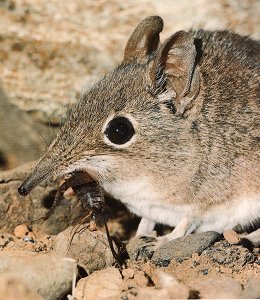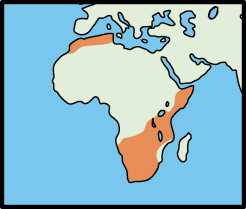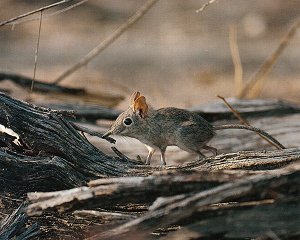THE ORDER MACROSCELIDEA
Table of Contents
Macroscelidea – Big Pests – Mammals (About 15 species.) Mammals of the Southern African Sub-region
The elephant shrews are the only members of this order. In many ways similar to the insectivores (in fact, formerly classified as a family of that order), these peculiar African animals are highly specialized for running. Their legs are long and slender; the back legs are somewhat longer than the front ones, giving them an almost kangaroolike appearance as they make their speedy bounds.

Their name obviously derives from their long noses being compared to that of an elephant. Their brains are more developed than the average Insectivore, and they can live in a variety of habitats, including open plains, savannas, and tropical forests. At one time or another, the elephant shrew was compared to primates, insectivores, tree shrews, and even the hooved animals. Finally, they have been placed in order unto themselves. Unfortunately, little is known of these animals, other than that they are monogamous, territorial, and breed throughout the year. The other known fact is that more than half of the species are either endangered or vulnerable to extinction.
Check out the North African Elephant Shrew and the Giant Elephant Shrew.
North African elephant shrew – ELEPHANTULUS ROZETI
 Possibly Endangered
Possibly Endangered
- Class: Animals with Milk Glands (Mammalia)
- Subclass: True Mammals (Eutheria)
- Order: Big Pests (?) (Macroscelidia)
- Family: Macroscelididae.
The Name “shrew”: Middle English for “villain,” the shrew is probably so-called because of its pugnacious manner. Since it has a long nose, it is called an “elephant” shrew.
Location: Northwestern Africa.
Habitat: Terrestrial. Semi-desert.

Description: This elephant shrew is a small, mouse-like insect eater with a long tail, long hind limbs a sharply pointed snout, and large ears. The dense fur is light brown on the back and white beneath. Not including the tail, the elephant shrew grows to about 3.5″ to 5″ and weighs between 1 and 2 oz.
Behavior: About fifteen species of elephant shrews are found throughout Africa in various habitats. The animals are considered a separate order by many authorities because it is such a distinctive group. Although the elephant shrews resemble the mouse kangaroos with their long hind legs, they actually walk on all four and hop only when running. This North African species lives in isolation in an open arid country. It seeks shelter by burrowing underground or hiding under rocks. It is active during the day but spends the hot midday hours in its burrow. It primarily eats insects for its food.

Reproduction: The reproductive habits of this species are unknown, but the closely related East African elephant shrew bears one or two young per litter after a gestation of fifty days. After only one month the baby shrews are weaned, and they are completely on their own by two months.
Giant elephant shrew – RHYNCHOCYON CIRNEI
Possibly Endangered
- Class: Animals with Milk Glands (Mammalia)
- Subclass: True Mammals (Eutheria)
- Order: Big Pests (?) (Macroscelidia)
- Family: Macroscelididae.
The Name “shrew”: Middle English for “villain,” it probably is so-called because of the shrew’s pugnacious manner. Since it has a long nose, it is called an “elephant” shrew.
Location: Eastern central Africa.
Habitat: Terrestrial, preferring tropical and subtropical forests and woodlands.

Description: This shrew is hunch-backed due to its long legs, and about the size of a rat. Its tail is long and tapering, and its nose is long and pointed in the opposite direction. It has four toes on its hind feet. The fur ranges from beige to orange to nearly black, usually with light-colored stripes running lengthwise. The giant elephant shrew is over twice as large as its North African cousin, measuring 9.5″ to 12.5″ not counting the tail, and weighing in at 2.8 to 4.2 oz.
Behavior: This is the largest of the elephant shrews, living in shady areas with leaf litter, in which it resembles a small anteater using its long nose and scratching with its feet to locate ants, termites, and other small creatures. Often living in pairs or small groups, giant elephant shrews are active during the day and occasionally at night, squeaking constantly to keep in touch with the others, and rapping their tails when alarmed.
Reproduction: Both sexes are territorial, marking stones and twigs with the scent from a gland at the base of the tail. Their nest is a modest mound of leaves piled in a shallow depression in the ground. The giant elephant shrew bears one fully-haired young baby at a time, but cycles through pregnancy four or five times each year. The baby stays in the nest for about three weeks and then follows its mother for another week before it is on its own.
